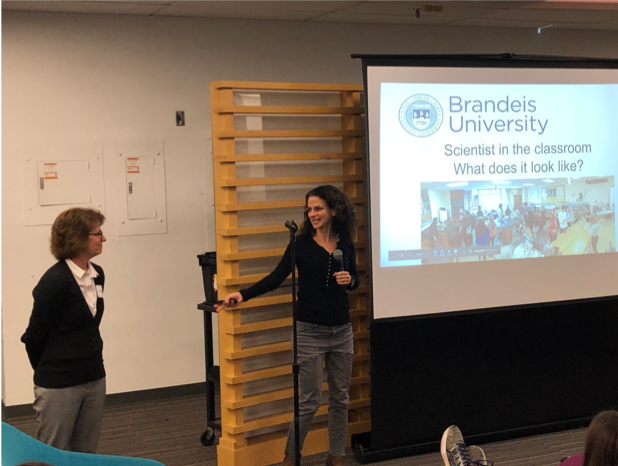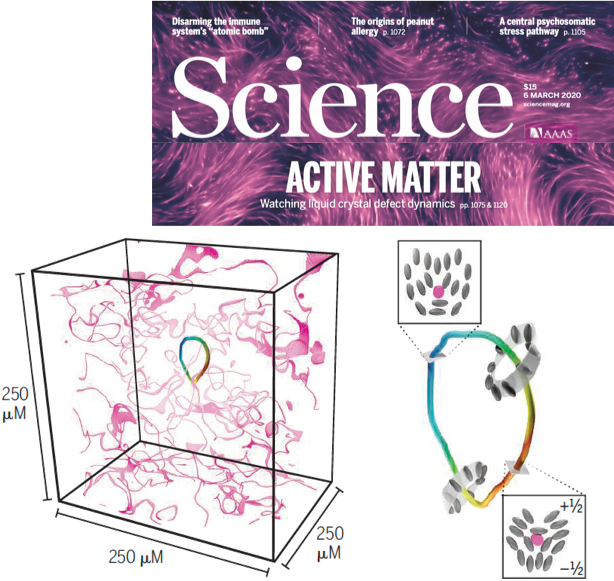Highlights
Highlights of IRG research are reported on an ongoing basis to the NSF MRSEC program.
2020

Sixty undergraduates participated in a SciComm Lab facilitated workshop designed to increase awareness of the REU program and encourage students to apply.
The Brandeis MRSEC is committed to broadening participation of underrepresented groups (URGs) in materials research. This year, Olivier-Mason, with the SciComm peer mentors, piloted an outreach initiative with Fisher College, a small college in Boston with a large population of students from underrepresented groups. The goal was to enhance awareness of and preparation for the nation-wide NSF-REU program. Many students from URGs are unaware of the potential of this opportunity, and lack the skills needed to write a successful application. They may be too busy working while studying, or have inadequate mentorship to complete the lengthy and arduous application process.
In the pilot at Fisher College, there were twooutcomes: 1) sixty undergraduates attended a one-hour long workshop open to all students interested in any REU program across the nation. 2) Six students met one on-one with three SciComm Lab peer mentors for individual REU application coaching.
Next, we will scale-up this pilot to increase URM participation in REUs. Notably, this is a relatively lowcost initiative that could have a profound impact on national REU demographics if scaled

Theory and Experiment on self-limited sized membranes formed from rodlike chiral liquid crystalline molecules. (a) Theory: Enneper surfaces of m=1, 2, 3, and 4. (b—e) Experiment: Membranes formed from the filamentous virus fd. 3D false-colored confocal images of saddles with order m=1, 2, 3, and 4. (f) Experiment: 3D rendered images of an m=6 order saddle surface. All scale bars are 2 mm.
Producing self-assembled structures of prescribed limited size and shape is a major challenge in nanoscience. A major achievement of the MRSEC was to elucidate a new chirality-based mechanism that leads to self-limiting assembly of colloidal rafts. A two-dimensional colloidal membrane with free edges and
composed of chiral rod-like viruses is an example where both chirality and membrane deformability are key components of the system. The interplay of chirality and deformability leads to the formation of beautiful three-dimensional Enneper structures driven by the negative Gaussian curvature of the membranes that arises because of the chirality of the molecules.
Experiments on membranes formed from filamentous virus were combined with theory and computation in this study.

Bend-twist instability in confined 3D active nematics. Chandrakar et al. studied the impact of confinement on the instability of a 3D active liquid crystal composed of microtubule bundles and kinesin molecular motors. Combing experiments with fluorescent microscopy and linear stability analysis of an hydrodynamic model, they showed that bend and twist deformations are coupled leading to an in plane instability whose wavelength depends on the out-of-plane confinement.
Spontaneous growth of long-wavelength deformations is a defining feature of active fluids with orientational order. In particular, for unconfined extensile active nematics, minimal hydrodynamic models predict that the fastest-growing deformation has an infinite wavelength.
Here [1], three IRG2 PP developed a combination of experiments with 3D active fluids confined in microfluidic channels and a minimal hydrodynamic model to show that size of the channel determines the emergent lengthscale of the growing deformations.
These findings will advance our understanding of active nemato-hydrodynamics and the pathways to 3D active turbulence at low Reynolds number.
[1] Chandrakar, Varghese, Baskaran, Dogic, and Duclos, Phys. Rev. Lett. 125, 257801

Brandeis REU participants recorded five-minute videos describing their summer research projects. Each REU participants was guided by a summer mentor.
This year Brandeis MRSEC has continued its tradition of providing comprehensive summer research experiences for undergraduate students through the REU program. Due to COVID, the Center translated the experience to a virtual research project and five talented students from underrepresented groups were able to complete projects under the guidance of MRSEC faculty, postdoctoral fellows, and graduate students.
The virtual program included weekly science seminars, career development and graduate school planning, and regular journal club meetings with the summer culminating in a 5-minute video presentation.
Through external evaluation, participants the virtual REU program indicated an increase in understanding of science, self-efficacy, and likelihood of continuing in science that was consistent with the previous four years of in-person programming.

PP Avi Rodal and Waltham teacher Ellen Stanton speaking to teachers and scientists gathered for the Watch-City Forum. This event celebrated Brandeis as a hub of innovation and discovery and promoted SciLinkR.com as a way to connect the broader community with professionals and promote science.
The inaugural Watch-City Forum, a full-day event connecting scientists and teachers, took place on November 5, 2019. The Brandeis MRSEC led a Brandeis team of scientists, technologists, and librarians to develop and execute the event.
In the first half of the day, 21 Waltham teachers met in small groups with 15 Brandeis scientists for “behind the scenes” tours of Brandeis research labs. The teams developed curriculum for future visits by the scientist(s) to the middle and high school classrooms.
In the second half of the day, attendees listened to talks from teacher-scientist teams about past examples of successful scientist-in-the-classroom visits and had the opportunity to engage with other scientists presenting scientific posters of their work. There were also hands- on booths with science demos, and tables with representatives from local companies. All attendees were encouraged to create SciLinkR.com profiles.
To minimize the cost to the MRSEC, funds were raised from local companies in exchange for table access at the event.

Spontaneous curvature of domain edges in colloidal membranes. (A) Fluorescence images of long-rod rafts with increasing sizes. Increasing the area of a long-rod raft induces a shape transition from a circular droplet to elongated shapes before transforming into a horseshoe and eventually a complete annulus. (B) Theoretical prediction for the phase diagram of long-rod raft shapes as a function of raft area and the length difference between two rod species.
Immiscible fluids, such as oil and water, bulk phase separate leading to formation of liquid droplets. In 3D isotropic fluid mixtures droplets assume, on average, a spherical shape which minimizes the interfacial area, and thus the system free energy. Designing reconfigurable liquid droplets that adopt a broader class of non-spherical shapes remains an experimental challenge without a robust solution.
This study of liquid-liquid phase separation in a binary colloidal membrane composed of length asymmetric achiral rods demonstrates that the behavior of membrane-imbedded 2D liquid droplets is fundamentally different from their 3D bulk counterparts. Using a combination of theory and experiments, a universal geometric mechanism is developed which yields an interfacial tension between two liquids domains that selects a preferred edge curvature. Curvature-dependent interfacial tension has important consequences on the structure of membrane imbedded droplets. It selects stable finite-sized droplets independent of the constituent’s chirality. It also destabilizes large circular droplets, giving rise to an array of unique non-convex and annular domain shapes.

Deformations in 3D LCs (L) Duclos et al. used high-resolution microscopy to image the director field. They located the extended defects (the linear structures) formed by internally driven bending instabilities. Defect connections (R) The wedge-twist loop connects +1/2 and -1/2 defects like a Möbius strip. This smooth evolution can only occur in 3D materials and not in thin films.
Topological structures are effective descriptors of the nonequilibrium dynamics of diverse many-body systems. For example, motile, point-like topological defects capture the salient features of two-dimensional active liquid crystals composed of energy-consuming anisotropic units. Here, force-generating microtubule bundles are dispersed in a passive colloidal liquid crystal to form a three-dimensional active nematic. Light-sheet microscopy revealed the temporal evolution of the millimeter-scale structure of these active nematics with single-bundle resolution. The primary topological excitations are extended, charge- neutral disclination loops that undergo complex dynamics and recombination events. This work suggests a framework for analyzing the nonequilibrium dynamics of bulk anisotropic systems as diverse as driven complex fluids, active metamaterials, biological tissues, and collections of robots or organisms.

DNA origami shells. (A) The concept is to encapsulate covid-19 in a DNA origami shell to deactivate virus. (B) Cylindrical model of DNA-origami triangle constructed using a single circular 8064 base scaffold. The edges of the triangles are beveled and modified with shape- complementary protrusions (light) and recesses (dark) that guide assembly via “lock” and “key” interactions into octahedra (O) and icosahedra (T=1). (C) Octahedral and icosahedral shells formed by the triangles shown in (B). For each shell design, one of its monomers has been removed. α is the bevel angle of the sides, # the number of DNA-origami triangles building the shell. (D, E) High resolution cryo-EM images of the octahedral (D) and icosahedral (E) monomers and capsids.
DNA origami technology is used to develop building blocks that self-assemble into predetermined finite-sized structures. The objectives of this research are to understand, control, and build self-closing structures inspired by self-assembling viruses, whose smallest capsids have an icosahedral symmetry and are decomposable into so- called “quasi-equivalent” triangular subunit arrangements, characterized by the “T” number. Assembly occurs using programmed edge-edge interactions based on a lock-and- key mechanism and base stacking between the blunt ends of the double-helices. Researchers have successfully designed, assembled and characterized capsids of octahedral and icosahedral symmetry. A potential application is to encapsulate viruses within a shell and therefore deactivate them.